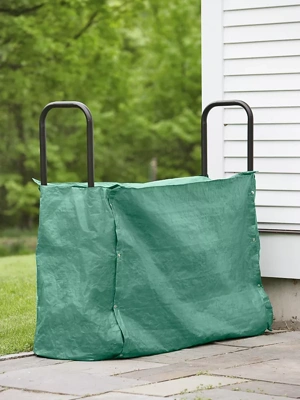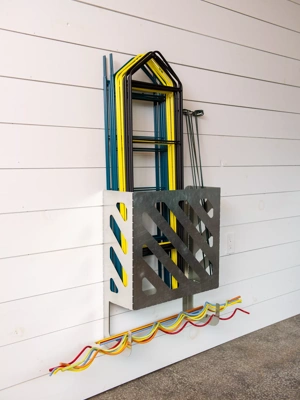How to Harvest, Cure, and Store Onions
Tips for keeping garden-fresh onions fresher longer!
 Our 6-Drawer Orchard Rack is ideal for storing onions. The drawers ensure good air circulation, and they slide out for easy access. For best results, the rack should be located in a cool, dark cellar, or shed.
Our 6-Drawer Orchard Rack is ideal for storing onions. The drawers ensure good air circulation, and they slide out for easy access. For best results, the rack should be located in a cool, dark cellar, or shed.Getting Fresh Onions From Your Garden to Your Kitchen
Onions are a basic aromatic element in cuisines around the world and a staple in nearly any home kitchen. But there's nothing worse than reaching for that last onion and finding it rotten! If you've taken the step of growing your own supply of garden-fresh onions, we'll give you the tips you need to harvest your onions at the peak of freshness, and how to cure and store onions for long-lasting use.
 To cure, spread the onions on some scrap building paper (newspapers or even the bare floor is fine).
To cure, spread the onions on some scrap building paper (newspapers or even the bare floor is fine). 9 Drawer Wooden Orchard Rack
9 Drawer Wooden Orchard RackHow You Know When Onions are Ready to Harvest
Harvesting onions is easy, and is the same for all globe onions. By midsummer, when the bulbs start to fatten up, you can begin harvesting individual onions as needed. There are 3 tell-tale signs that your onion is ready to harvest:
- Tops Flop Over
- Necks Go Soft
- Leaves Turn Yellow or Brown
In late summer or early fall, the leaves on your onion plants will start to flop over, turning yellow or brown, and beginning to dry out. This happens at the "neck" of the onion, where the leaves meet the bulb, and it signals that the plant has stopped growing and is ready for storage. Onions should be harvested soon thereafter.
Harvesting Onions From Your Garden
When your onions are ready to come out of the ground, carefully loosen the surrounding soil with a pitchfork, then gently pull the onions up by their tops. To prevent the possibility of rot, try to keep the full stem intact.
If the weather is dry and there's no danger of frost, the plants can be laid right in the garden for a day or two before beginning the curing process. If the weather is wet or frost is possible, move the onions immediately into a protected spot. The floor of the garage or a covered porch works well.
What Does it Mean to "Cure" Onions?
Don't worry, your onions aren't sick. As with other foods, curing is a process of prepaing onions for long-term storage. During the curing stage, the outer layers of the onion dry out, tightening around the bulb and creating a protective layer that keeps the onion firm and fresh for longer.
How to Cure Onions
Curing onions is a super simple process, and the most important thing to remember is: you're trying to dry them out, so make sure your onions have plenty of space for air to circulate, and turn the onions every few days to make sure they dry evenly. Ideal conditions for curing onions are warm (75-80 degrees F), dry, breezy, and out of the sun. Spread the onions out in a single layer, taking care not to bump or bruise them.
When Are Onions Done Curing
As the onions are curing, their necks will gradually wither and the papery skins will tighten around the bulbs. Once the necks are completely tight and dry, and the stems contain no moisture, you can use scissors to trim the roots off the bottom of each bulb. The leaves can also be trimmed to within 1″ of the bulb. Cull any onions that still have green necks, or have bruised or damaged bulbs.
The Best Way to Store Onions
For best results, onions should be kept in a dark, dry, cool space (35 to 40 degrees F) like a cellar, garage, or shed. To maintain peak flavor and prevent rotting, ensure proper air circulation by storing onions in mesh bags, a bushel basket, orchard rack, or a flat cardboard box with some holes punched in it.
How Long Will Onions Keep?
There are two main types of globe onions: pungent and mild. Mild (or sweet) onions, like Spanish, Bermuda, Vidalia, and Walla Walla Sweet, should be used up within a few weeks.
Pungent (or storage) onions that will be stored for the winter, including Candy, Copra, Red Weathersfield, and Ebenezer, need to be cured for two to four weeks. When cured and stored properly, a good storage onion will retain its eating quality for 10 to 12 months.
How to Tell The Difference Between Mild and Pungent Onions
If you ask a roomful of good cooks what vegetable they consider indispensible, many will name the onion. Adding pizzazz to pizzas, sizzle to steaks, and a tsunami of umami in cuisines around the world, globe onions are an essential ingredient — across the globe!
Popular "Mild" Onion Varieties:
- Spanish
- Bermuda
- Vidalia
- Walla Walla Sweet
Mild onions are typically large and juicy with thick rings and thin, papery skins that peel easily. They can be cooked, but can also be eaten raw on sandwiches or burgers. And mild onions are the ones you want inside an onion ring. Unfortunately, mild onions are poor keepers. Even in ideal storage conditions, they will only maintain their eating quality for a couple months. So if you grow both mild and pungent onions, eat the mild ones first. A bumper crop of mild onions can be preserved in pickles, salsas, and chutneys or you can turn them into caramelized onions.
Popular "Pungent" Onion Varieties:
- Candy
- Copra
- Red Weathersfield
- Ebenezer
Pungent onions are usually smaller in size, have thinner rings, tighter skins and make your eyes sting when you chop them. The same sulfurous compounds that bring tears to your eyes also inhibit rot, so the more pungent the onion the longer it will store. Or, put another way:
The more you weep, the longer it'll keep!
Related Articles
Last updated: 09/06/2023
Print this Article:
Related items
Get the Dirt
Stay up to date on new articles and advice. Please fill out the information below.









